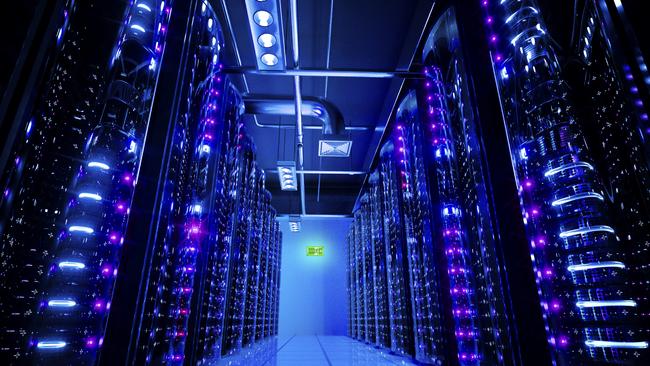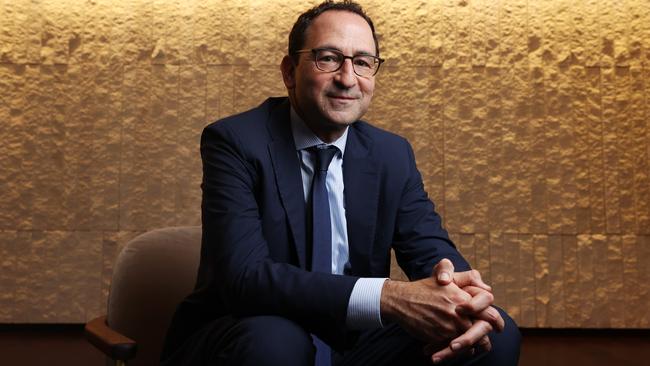AirTrunk is classic Blackstone: Go big, go for scale
Three years ago Wall Street giant Blackstone had next to no funds in data centres but today it has more than $186bn. Here’s why.

With all the talk about the eye-watering sums Blackstone has put on AirTrunk through the blockbuster data centre deal, take a step back; it really is a modest bet for the $US1 trillion Wall Street giant.
As fitting as the deal’s codename, Project Amidala (named after the key Star Wars character, the teenage queen of the fictional planet Naboo), the $24bn price tag put on the Macquarie-backed business is out of this world for a business which changed hands for $3bn five years ago.
Digital infrastructure such as data centres rank among the highest conviction play in Blackstone’s four big investment thematics. The other themes in its playbook include commercial real estate, private credit and renewable energy.
And across each of its chosen areas, Blackstone wants to be the biggest in class as it chases the scale game. By putting all parts of its portfolio to work Blackstone, along with its smaller partner in the AirTrunk deal, Canada Pension Plan Investment Board, can afford to pay over-the-top multiples.

It is already the world’s largest private credit manager. It is the largest private owner of warehouses in the world; it is the largest private renewables developer in the United States. And now the bet on data centres represents among the biggest in the world.
Think of Blackstone’s ecosystem. On top of the digital infrastructure and lots of capital, what else does a data centre need? A very big warehouse – and lots and lots of renewable energy. Blackstone can help with that too.
Blackstone’s chief operating officer, Jon Gray, sat down with The Australian in the asset manager’s Sydney offices in May, where he spoke of already having a $US125bn ($185bn) pipeline of data centres under construction or at various phases of developments.
Just a little more than three years ago the figure was close to zero. This gives you a sense of how extraordinary Blackstone’s data centre ramp-up has been.
Indeed AirTrunk first came on Blackstone’s radar five years ago when it was sold to Macquarie. Blackstone, which had no experience and little to no capital in the space, opted at the time to sit out. About a year ago Project Amidala was launched by Macquarie and intensive talks have been under way until this week’s deal.
AirTrunk, with its super-sized data centres dotted across five countries in Asia serving the biggest tech customers in the world, will help accelerate Blackstone’s exposure even more.
No one else has the same footprint in the region and to match it would take an outside player a long time.
Blackstone is looking at AirTrunk’s growth potential by using its massive balance sheet to fund further growth. With the right execution this could make the business a $100bn proposition (equivalent to 8 to 10 gigawatts of demand). Suddenly $24bn is looking fairly valued.
AI boom
Why have data centres suddenly become so big for Blackstone?
“It is the physical manifestation of AI with large language models,” Gray told The Australian in May.
“To have a large language model, you need those GPUs (graphics processing units) inside the data centre consuming a lot of energy and doing this incredible computational work that is going to transform all our lives.”
But in Blackstone’s case the asset manager isn’t just betting on who is going to win the AI race, as names like Apple, Amazon, Google-owner Alphabet, Microsoft and Meta all jockey for dominance.
“We’re basically providing the infrastructure, the rails for them to do it,” Gray says.
With AI and cloud computing driving demand, Blackstone is playing in a field where $US1 trillion of capital will be needed in the US over the next five years to build and facilitate new data centres.
Another $US1 trillion of capex will be spent across the rest of the world. All this comes as hundreds of billions of dollars will be spent building out AI technology.

Gray says consequences of AI are as profound as what occurred in the late 1800s when Thomas Edison patented the electric light bulb.
“While it took years to develop commercially viable products, the subsequent build out of the electric grid over the following decades has parallels to the creation of data centres today to power the AI revolution,” Gray says.
For Blackstone’s own investors, a hyperscaler like AirTrunk helps lower overall platform costs.
AirTrunk is already the largest independent data centre operator across Asia. The assets represent long-term cashflows with built-in indexation and rapidly rising demand as the use of data surges. All this translates to huge volumes of cash coming out of AirTrunk, which can be deployed into more sites.
And Blackstone’s scale means the cash can be generated at a lower cost than many other private asset managers, including Macquarie.
One of Blackstone’s current data centre investments, QTS, has grown leased capacity seven times since it acquired it in 2021. Through QTS, Blackstone gets exposure to tech customers whereby it can onsell other things like energy, equity and debt capital.
In recent months, Blackstone committed to provide AI-focused cloud service provider and QTS customer Coreweave more than half of its $US7.5bn financing package – the largest debt financing in Blackstone’s history.
AirTrunk is set to open many more digital doors for Blackstone.
TPG goes bush
With telco infrastructure in focus, TPG Telecom boss Inaki Berroeta finally has a plan to grow in regional Australia.
TPG’s $1.6bn network sharing deal with Optus outside the capital cities has received the green light from the competition regulator. This is the plan B after TPG’s initial Telstra link-up was knocked back by the same regulator last year.
Plan B or not, it still gives the third-ranked telco the critical boost it needs while delivering Optus access to spectrum to support its 5G network.
And while the sharing of network and towers is about coverage in the bush, the reality is all the competitive action will most likely take place in the cities.
Under the deal TPG, which operates the Vodafone brand, will pay Optus $1.6bn over 11 years for access to the bigger telco’s regional network.
The venture will also result in Berroeta’s TPG tipping in its holdings of spectrum covering regional Australia as well as about 800 phone towers being transferred across to Optus or decommissioned. Optus will, in turn, pay TPG a $420m leasing fee for the towers. This means the cost of the deal comes down to $1.17bn.

For TPG there are three key benefits.
It represents an immediate doubling of the reach of its mobile network. And while the agreement covers the final 20 per cent of the population, it puts TPG back in the competitive game in the cities. For most Australians, coverage and reach are the big driver when it comes to customers choosing their telco.
Secondly, it is likely to reduce customer churn for TPG where, at 15 per cent, it is running at a higher rate than rivals. In a current flat to low single-digit growth mobile market, if TPG can hold on to more of its own customers this is a good lever for growth.
Finally, the network sharing deal gives TPG a platform to compete more aggressively in the business market because enterprise customers are also looking for certainty of coverage.
TPG estimates the immediate lift in getting access to the Optus network represents a third of the cost if it were to build, operate and maintain a similar sized network across regional Australia.
Last year the ACCC knocked back a plan for TPG and Telstra to strike a similar deal.
The ACCC’s decision was upheld on appeal, due to concerns it would entrench Telstra as the overwhelmingly dominant telco in regional Australia.
The regulator was won over by Optus’ arguments that a Telstra-TPG deal would be a big disincentive for the second ranked player to invest in network infrastructure in the bush – which would be bad for competition in the long run.
With two rivals teaming up, the heat will now be on Telstra to hold on to its position in regional Australia.
eric.johnston@news.com.au
Originally published as AirTrunk is classic Blackstone: Go big, go for scale



